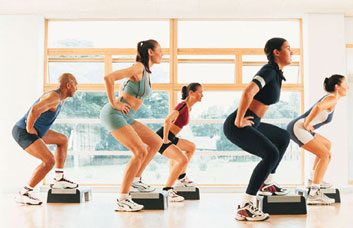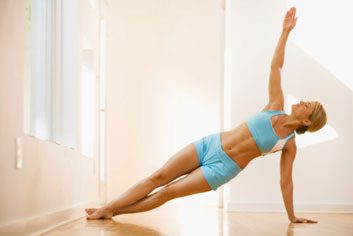
Circuit training
Any movement is better than sitting still when it comes to improving your heart health, but one of the best types of exercises to increase your cardiovascular fitness is circuit training, says Brendan J. Fox, a Toronto-based health and fitness expert. “When you work out at a very high intensity the blood starts to pump a lot harder and that challenges the elasticity of the arterial wall,” explains Fox. “It sort of stretches the arteries and improves the elasticity for better cardiovascular fitness.” Opting for minimal rest periods, and alternating between upper and lower body exercises is the ideal way to get maximum results.

Lane swimming
Hit the pool for a workout your heart (and lungs!) will love. “Leisure swimming only brings benefits for the extremely unfit population,” says Fox. “Lane swimming will give you a greater return on your exercise time investment.” His recommendation? Progressing from eight to 12 lengths of the pool per swim technique, varying techniques on different days. This could mean doing front crawl and legs only with a flutter board one day and then back crawl and breast stroke another day. One swim technique guaranteed to bring up your fitness level is fist freestyle, which is using closed fists for any swim style, explains Fox. “You have to work harder because you don’t have any swim paddle effect with the open hand.”

Weight training
“Weight training is critical for people with heart disease,” says Dr. Paul Oh, medical director of the Cardiac Rehabilitation and Secondary Prevention Program at the Toronto Rehabilitation Institute. In addition to building muscle mass, which will help you burn fat, weight training is also good for bone health and your heart. When it comes to deciding what type of weight training to do, using your own body weight can be extremely effective. “The challenge is incorporating proper progression,” says Fox, who recommends adjusting the tempo of your movements to increase the difficulty. For example, once you can do 20 push-ups with ease, challenge yourself by slowing down and counting to four as your raise yourself up and then again as you lower.

Running
A steady run is obviously an excellent way to stay in shape, but running intervals will really push your cardiovascular fitness to the next level. Whether it’s sprints or hills, all you need is 10 seconds at a time. “I recommend keeping the intensity at 10 seconds to ensure you go all out,” says Fox, who suggests starting with four 10-second intervals per workout, eventually working your way up to 10. He also recommends doing the intervals first, so not only do you have the energy to do them, but this type of training will deplete some of the glycogen or carbohydrate stored in the muscle, allowing you to tap into stored fat more readily. Bonus!
Tip: Work hard enough to get out of breath and then take whatever minimal rest period you need to recover, says Fox.

Yoga
You don’t have to be doing a high level of activity to increase your heart health, admits Dr. Oh, who says that pushing your heart rate up and down quickly can be hazardous to those who are out of shape (heart attacks that occur while shovelling snow is an example of this). At first glance, yoga may not seem like an obvious heart health activity, but it is. “Yoga is great for strength and muscle toning,” says Dr. Oh. Plus more active styles of yoga such as Ashtanga and Bikram can offer cardiovascular benefits, as your heart rate is elevated throughout the class.

Cycling
Regular cycling can substantially reduce your risk for coronary heart disease, according to a large study done by the British Medical Association. The findings revealed that cycling 32 kilometres a week reduced the potential to develop heart disease by a whopping 50 percent. Cycling uses large muscle groups in the legs to elevate your heart rate, which helps to improve not only your cardiovascular fitness but also burns calories, and has even been shown to improve mental health.
Tip: No matter what exercise you choose to do, 30 minutes, five days a week is an ideal place to start, says Dr. Oh, who recommends building up to one hour, five days a week.
Related:
• 8 surprising heart disease risks
• 4 ways yoga is good for your heart
• 10-Minute Tuneups: Boot camp workout video
